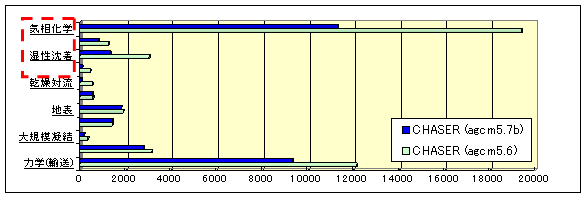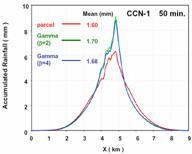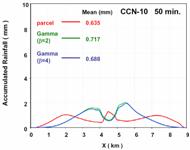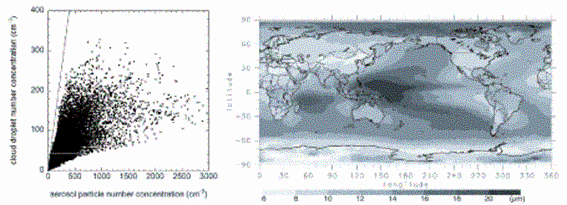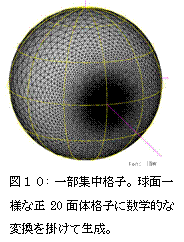(2) Warming and an atmospheric composition interaction model subgroupResults Page | Top Page |
|||||||||||||||||||||
(1) Warming and an atmospheric composition change interaction model(1)-a Improvement of the troposhere atmospheric chemistry model CHASER bearing a transplant to an integrated model in mind(1)-b Introduction of the stratosphere chemical process to CHASER Outline In warming and atmospheric composition change interaction sub model, it is the present subject to set it as the main purposes to express and predict an interaction with warming of atmospheric chemistry process (ozone distribution etc.) or aerosol, and the ocean and terrestrial vegetation change, and to enable on-line calculation of aerosol and chemistry using all the ball chemistry models CHASER and the aerosol model SPRINTARS. The CHASER model was accelerated in the current fiscal year bearing in mind the long-term experiment at the time of including this sub model in an integrated model, and the preceding paragraph story-experiment for warming and atmospheric chemistry interaction prediction research was conducted further. Improvement in the speed of the chemistry model CHASER In all ball chemistry models, it is a pending question element at the time of the calculation cost of a chemical process (especially chemical reaction) being very large, and conducting a long-term experiment as compared with calculation of the climate model used as the stage of a chemical process. moreover, since increasing further is expected, the calculation cost at the time of also introducing aerosol and stratosphere chemistry (the present condition -- troposhere chemistry) into CHASER as an integrated model needs to accelerate calculation of a chemical process as much as possible. It is CCSR/NIES agcm5.6 in the current fiscal year. The chemical process was accelerated while shifting CHASER which was a base to the agcm5.7b base. It succeeded in reducing the whole computation time about 35% by having mainly introduced the list vectorization technique into the chemical process, as shown in Fig. 3. Moreover, 20 more% of improvement in the speed also checked the possible thing by simplification of a chemical reaction system.
The influence experiment to the troposhere chemistry of warming In order to acquire the prospect of warming and an atmospheric composition change interaction, future warming experimented using CHASER about the influence (feedback) which it has on a chemical process (especially ozone distribution). Although Fig. 4 (a) is an example of the prediction result of the latitude and advanced distribution of the amount of ozone in 2100 at the time of taking into consideration only the increase in artificial origin outgassing which carried out the east-and-west average, Furthermore, when the influence of warming was also taken into consideration, as shown in Fig. 4 (b), since an ozone destruction was promoted by the increase in steam accompanying warming, ozone (the amount of increases) decreased in the troposhere lower layer, and since the ozone inflow from the stratosphere increased remarkably by strengthening of the meridional circulation (especially stratosphere circulation) by warming, in the troposhere upper layer, the increase in ozone was calculated conversely. As for such warming influence, it was checked that methane and sulfuric-acid aerosol also influence a survey greatly future beforehand not only through ozone but through a chemical reaction. Future subject and schedule Although there is combination with various aerosol (SPRINTARS base) and a chemical process as a future target, work is advancing about this now and improvement of the simulation (mode of expression) of sulfuric-acid aerosol or organic carbon aerosol is also planned.
Furthermore, about the discharge process of the DMS and hydrocarbon in the ocean and terrestrial vegetation, and a gaseous descent self-possessed process, it combines with each component, which are the ocean and terrestrial, and integrated modeling is carried out.
Moreover, about the warming influence experiment reported in the top, the additional (sensitivity) experiment including other scenarios is required.  Figure 4 : (a) Ozone east-and-west average distribution in 2100 calculated in the standard experiment (only emission change) (A2 scenario), (b) Difference at the time of also taking warming into consideration (warming experiment-standard experiment). The tropopause is also shown (black solid line : black Dashed-line: 2100 warming, standard experiment).
Figure 4 : (a) Ozone east-and-west average distribution in 2100 calculated in the standard experiment (only emission change) (A2 scenario), (b) Difference at the time of also taking warming into consideration (warming experiment-standard experiment). The tropopause is also shown (black solid line : black Dashed-line: 2100 warming, standard experiment). (1)-b Introduction of the stratosphere chemical process to CHASEROutlineBy this subgroup, two work was done towards introduction of the stratosphere chemical process to an integrated model. It is examining what chemical species it including, in case one is extended so that the troposhere photochemistry model's CHASER may be included to a stratosphere chemical process, and another is verifying the conveying space in the stratosphere and the troposhere using the high precision advection current scheme mounted in the last fiscal year. Examination of a stratosphere chemical process Halogenated compounds, such as chlorine and bromine, play a role important for the ozone destruction in the stratosphere according to the catalytic cycle action. For this reason, it is very important in a stratosphere chemical process to take the reaction system of these compounds into consideration. The reaction system used by stratosphere photochemistry models (Takigawa et al., 1999, 2002, Nagashima et al., 2002, Akiyoshi et al., 2003, etc.) was added to CHASER towards mounting of the stratosphere chemical process to the integrated model after the following fiscal year, and calculation speed using a box model was presumed (Table 1).
Table 1 Reaction process at the time of using box model based on CHASER, and change of calculation speed Table 1 shows [ at this time ] that may be become heavy more than twice, when even a chlorine system compound is added, since it is necessary to newly take into consideration the reaction of long-life life gas, such as methane and a dinitrogen oxide, etc. in addition to a chlorine system compound. Moreover, even if it puts in even a bromine system compound from the result of this box model, it does not necessarily become so heavy. In case it actually mounts in an integrated model, I want to examine introducing the reaction system which includes even a bromine system compound first from these results. Verification of a transport process 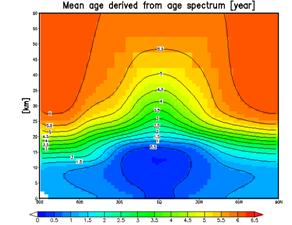 It continued at the last fiscal year and conveying space using a passive tracer was verified. This fiscal year performed comparison with the actual age presumed from the result of aircraft observations, such as carbon dioxide in the lower stratosphere, after searching for the average age (time which has passed after air went into the stratosphere), and age distribution especially paying attention to the stratosphere.
It continued at the last fiscal year and conveying space using a passive tracer was verified. This fiscal year performed comparison with the actual age presumed from the result of aircraft observations, such as carbon dioxide in the lower stratosphere, after searching for the average age (time which has passed after air went into the stratosphere), and age distribution especially paying attention to the stratosphere.  An integration period is ten years and conducted the ensemble experiment of eight examples using the Earth Simulator. Consequently, although the average age in an equatorial region was well in agreement with the point estimate from observation, the tendency for average age to become young like other three dimension models in inside and high latitude as compared with the point estimate from observation was seen. It is due to evaluate after the following fiscal year also about the stratosphere and troposhere mass exchange flux while investigating about the resolution dependability of level transportation.
An integration period is ten years and conducted the ensemble experiment of eight examples using the Earth Simulator. Consequently, although the average age in an equatorial region was well in agreement with the point estimate from observation, the tendency for average age to become young like other three dimension models in inside and high latitude as compared with the point estimate from observation was seen. It is due to evaluate after the following fiscal year also about the stratosphere and troposhere mass exchange flux while investigating about the resolution dependability of level transportation. (2) A warming-cloud, aerosol, and radiation feedback precision evaluation(2)-a The advancement of parameterization for general circulation models using a detailed cloud physics model(1)-b Introduction of the stratosphere chemical process to CHASER parameterization of cloud particle number densityparameterization which asks for cloud particle number density from the upward flow speed in the capability and the cloud base as a cloud condensation nucleus of aerosol was developed using the result which repeated the numerical simulation by a detailed cloud physics model, and was obtained (Kuba and Iwabuchi, 2003, Kuba, 2003). It is expressed with the following following approximate expressions, and the cloud particle number density Nd (cm-3) is Nc (S) (cm-3). The number density of the aerosol (growth is continued exceeding a critical radius and it becomes a cloud particle) activated by degree of supersaturation S % and V (ms-1) are the upward flow speed in a cloud base. It depends for the value of S, and the function form of A and B on V. Nd = A Nc(S) / (Nc(S) + B ) (1) V < 0.2 ms-1 : S = 0.2, A = 4710 V 1.19, B = 1090 V + 33.2 (2) 0.2 < V < 0.5 ms-1: S = 0.4, A = 11700 V - 1690, B = 10600 V - 1480 (3) 0.5 < V < 1.0 ms-1 : S = 0.5, A = 4300 V 1.05 , B = 2760 V 0.755 (4) 1.0 < V < 3.0 ms-1: S = 1.0, A = 7730- 15800 exp(-1.08 V) , B = 6030- 24100 exp(-1.87 V) (5) 3.0 < V < 10.0 ms-1: S = 2.0, A = 1140 V -741, B = 909 V - 56.2 (6) Formula (1) (2) When it substitutes (4) The case where it substitutes is described in a and b of Fig. 6, respectively.
Fig. 6: Relation between cloud particle number density Nd and cloud condensation-nucleus number density Nc (S %). a: It was considered as S = 0.2% by the case where cloud base upward flow speed is less than 0.24 ms-1. b: It was considered as S = 0.2% by the case where cloud base upward flow speed is 0.5~2.0 ms-1. By introducing an approximate expression (1), the influence of aerosol can be made to be able to reflect in cloud particle number density, and the accuracy of radiation balance calculation can be raised by using parameterization which evaluates the optical property of the clouds of Kuba et al. (2003) further. Optical thickness It can express as follows. However, LWP (gm-2) is perpendicular addition liquid water content. τ = C Nd D C = 0.121 LWP 0.702 D = 0.274 LWP 0.0538 (7) Moreover, effective radius of the cloud particle of cloud base top each altitude Re (μm) can be expressed as follows, when the altitude from a cloud base is set to Z (m). Re = E Nd F E = 6.41 Z 0.380 F = - 0.288 Z 0.0254 (8) parameterization of cloud particle particle size distribution It is becoming possible to carry cloud physics model in a non-statics all ball model or a non-statics domain model. When cloud physics model is a bulk method, the influence of aerosol can be taken into consideration by using parameterization of the above-mentioned cloud particle number density, but in the case of the bottle method, in addition to it, it is [ parameterization of initial cloud particle particle size distribution ] needed. Kuba (2003) uses gamma distribution and is initial cloud particle particle size distribution. n (r) (cm-4) It expressed as follows, and coefficient A and B considered it as liquid water content, the cloud particle number density Nd (cm-3), and the function of liquid water content Q (g cm-3), it introduced into 2-dimensional simple cloud dynamics Dell, and comparison with the case where a detailed cloud physics model (par cell model) is carried was carried out. n (r) = A rβ exp (-B r) d r (9) A = Nd (4π ( β+ 3 )( β + 2 )( β+ 1 ) Nd / 3Q ) (β+1) / 3 /β! B = (4π ( β+3) ( β+2 ) ( β+1 ) Nd / 3Q )1/3 What gives a radiation property with the almost equivalent cloud particle particle size distribution in clouds was obtained. It is Fig. 7 which measured the addition precipitation for 50 minutes by the case (CCN-1) where there is much aerosol, and the case (CCN-10) of being few. From the cloud particle particle size distribution from which gamma distribution is acquired by the detailed cloud physics model of a parcel method, since there is no big difference in the average precipitation in a domain as expressed numerically (mm) in the figure although there is a certain amount of difference from the ability of width not to fully express existence of giant particle cloud physics widely, to a model with a grid spacing of several km or more, it can be called effective parameterization.
(2)-b Introduction of the fine physics process of the clouds and aerosol interaction in a general circulation model(1)-b Introduction of the stratosphere chemical process to CHASER In order to treat clouds and an aerosol interaction in detail in a general circulation model, the new number concentration of cloud particles diagnostic type was introduced to aerosol transportation / radiation model SPRINTARS (Spectral Radiation-Transport Model for Aerosol Species) (Takemura et al., 2002) which used CCSR/NIES AGCM as the base. In order for a general circulation model to estimate an aerosol indirect effect (influence aerosol affects climate through clouds and precipitation), parameterization expressing clouds and an aerosol interaction was required, but as for the number concentration of cloud particles, it was common to have introduced the diagnostic type only depending on the number concentration of aerosol simplified very much until now. However, big optionality was included in this diagnostic method, and it was the key factor of the quantitive uncertainty of the evaluation to an aerosol indirect effect. Then, it enabled it to express change of the diameter of a cloud particle and the efficiency of precipitation accompanying change of the number of aerosol in this research by introducing parameterization (Ghan et al., 1997) which diagnoses the number concentration of cloud particles other than the number concentration of aerosol also depending on the chemical composition and the particle size distribution of upward flow speed, the degree of supersaturation, and aerosol. This diagnostic type expressed clouds and an aerosol interaction. It means using Kohler theory as a base and introducing parameterization which 則(ed) in theory more. The aerosol to deal with is the black carbon, the organic carbon, the sulphate, the soil particle, and sea salt which is troposhere main aerosol, and particle size distribution differs, respectively. Moreover, since the grid average upward flow speed in the scale of a general circulation model was very small, it also introduced parameterization which can express the upward flow speed in clouds to some extent. The simulation result of the relation between the number concentration of aerosol and the number concentration of cloud particles is shown in Fig. 8. It turns out that both relation is not decided as 1 to 1, but it distributes depending on the chemical nature and the particle size distribution of upward flow speed or aerosol like the number concentration of cloud particles diagnostic type currently used by the past research. Temperature shows annual average distribution of the cloud particle effective radius in 273K or more cloud tops in Fig. 9. This simulation result is well in agreement with what is obtained by satellite observation etc. quantitatively, and the contrast that it is large marine [ where the diameter of a cloud particle is small ] is seen on a continent. Moreover, although the diameter of a cloud particle was overestimated by low latitude as compared with observation and underestimated by inside high latitude in parameterization by which the past was simplified, this problem was solved in parameterization introduced this time. The total ball average indirect effect radiation legal force of the artificial origin aerosol by this model is calculated with -0.8 W m-2. By performing detailed comparison with the observational data about clouds, and introducing the knowledge from a local model or a cloud resolving model from now on, it is necessary to repeat improvement so that clouds and an aerosol interaction can be expressed more appropriately.
(2)-c Development of the non-statics air model NICAM which aimed at direct cloud resolving with all balls(1)-b Introduction of the stratosphere chemical process to CHASER The important rate of climb is furthering succeedingly development of the non-statics air model NICAM calculated directly in the fine physics process of cloud formation.
Some improvement was performed about dynamics process. (I) In consideration of conservation of angular momentum, approximation of the shallow atmosphere was canceled and extension to the deep atmosphere which had broadening in the vertical direction was performed. (II) It corrected so that preservation of all energies including turbulent motion energy might be guaranteed with mounting of a turbulent-flow scheme. (III) The lattice generating method on which a lattice can be centralized for examination of each physical process in part was established (Fig. 10). Moreover, it was shown that the model which measured calculation speed with a spectrum conversion model on the Earth Simulator, and used the Junichi Mr. lattice by 10km or less of level grid spacing numbers is more advantageous.
The mounting situation about a physical process is the following. The scheme of warm Kessler (1969) type rain and an easy 氷昌 process of Grabowski (1988, 1999) were introduced into cloud physics process, and the squall line experiment was conducted using the concentration lattice as shown in Fig. 10 (Fig. 11). It turns out that formation of lower layer cold pool and systematization of the clouds in the upper layer are reproduced. Although the above is a thing about a bulk method, introduction of the bottle method based on more detailed cloud physics is also put into the view. in addition, the earth surface according to Mellor-Yamda level2, 2.5 turbulent-flow process, and Louis as main physical process -- finishing [ mounting of process ] -- it is .
|
